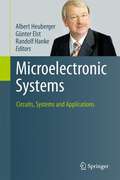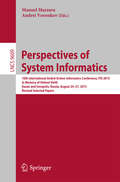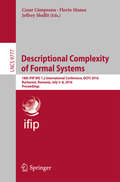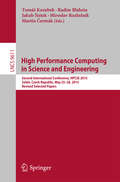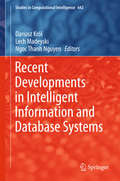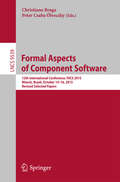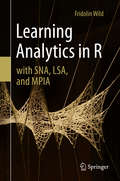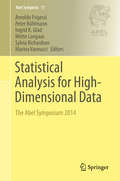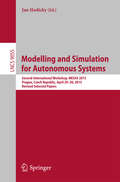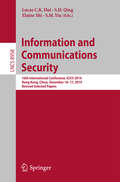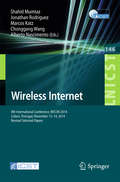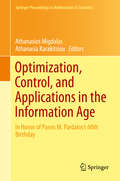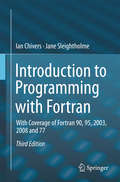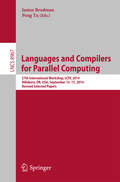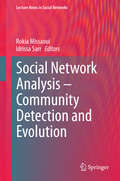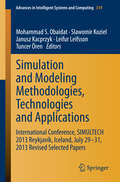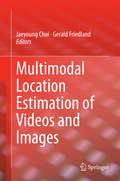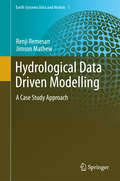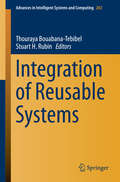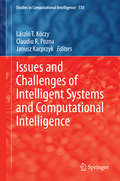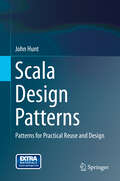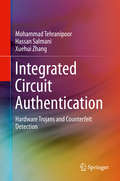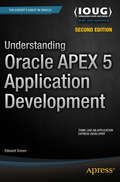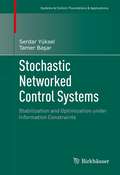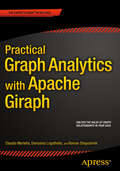- Table View
- List View
Microelectronic Systems
by Albert Heuberger Randolf Hanke Günter Elst Karlheinz Kirsch Janina HeppnerThis book is dedicated to Prof. Dr. Heinz Gerhäuser on the occasion of his retirement both from the position of Executive Director of the Fraunhofer Institute for Integrated Circuits IIS and from the Endowed Chair of Information Technologies with a Focus on Communication Electronics (LIKE) at the Friedrich-Alexander-Universität Erlangen-Nürnberg. Heinz Gerhäuser's vision and entrepreneurial spirit have made the Fraunhofer IIS one of the most successful and renowned German research institutions. He has been Director of the Fraunhofer IIS since 1993, and under his leadership it has grown to become the largest of Germany's 60 Fraunhofer Institutes, a position it retains to this day, currently employing over 730 staff. Likely his most important scientific as well as application-related contribution was his pivotal role in the development of the mp3 format, which would later become a worldwide success. The contributions to this Festschrift were written by both Fraunhofer IIS staff and external project team members in appreciation of Prof. Dr. Gerhäuser's lifetime academic achievements and his inspiring leadership at the Fraunhofer IIS. The papers reflect the broad spectrum of the institute's research activities and are grouped into sections on circuits, information systems, visual computing, and audio and multimedia. They provide academic and industrial researchers in fields like signal processing, sensor networks, microelectronics, and integrated circuits with an up-to-date overview of research results that have a huge potential for cutting-edge industrial applications.
Perspectives of System Informatics
by Manuel Mazzara Andrei VoronkovThis book constitutes the refereed proceedings of the 10th International Andrei Ershov Informatics Conference, PSI 2015, held in Kazan and Innopolis, Russia, in August 2015. The 2 invited and 23 full papers presented in this volume were carefully reviewed and selected from 56 submissions. The papers cover various topics related to the foundations of program and system development and analysis, programming methodology and software engineering and information technologies.
Descriptional Complexity of Formal Systems
by Jeffrey Shallit Florin Manea Cezar CâmpeanuThis book constitutes the refereed proceedings of the 17th International Conference on Descriptional Complexity of Formal Systems, DCFS 2015, held in Waterloo, ON, Canada, in June 2015. The 23 full papers presented together with 2 invited talks were carefully reviewed and selected from 29 submissions. The subject of the workshop was descriptional complexity. Roughly speaking, this field is concerned with the size of objects in various mathematical models of computation, such as finite automata, pushdown automata, and Turing machines. Descriptional complexity serves as a theoretical representation of physical realizations, such as the engineering complexity of computer software and hardware. It also models similar complexity phenomena in other areas of computer science, including unconventional computing and bioinformatics.
High Performance Computing in Science and Engineering
by Tomáš Kozubek Radim Blaheta Jakub Šístek Miroslav Rozložník Martin ČermákThis book constitutes the thoroughly refereed post-conference proceedings of the Second International Conference on High Performance Computing in Science and Engineering, HPCSE 2015, held in SoláÅ^, Czech Republic, in May 2015. The 14 papers presented in this volume were carefully reviewed and selected from 21 submissions. The conference provides an international forum for exchanging ideas among researchers involved in scientific and parallel computing, including theory and applications, as well as applied and computational mathematics. The focus of HPCSE 2015 was on models, algorithms, and software tools which facilitate efficient and convenient utilization of modern parallel and distributed computing architectures, as well as on large-scale applications.
Recent Developments in Intelligent Information and Database Systems
by Lech Madeyski Ngoc Thanh Nguyen Dariusz KrólThe objective of this book is to contribute to the development of the intelligent information and database systems with the essentials of current knowledge, experience and know-how. The book contains a selection of 40 chapters based on original research presented as posters during the 8th Asian Conference on Intelligent Information and Database Systems (ACIIDS 2016) held on 14 16 March 2016 in Da Nang, Vietnam. The papers to some extent reflect the achievements of scientific teams from 17 countries in five continents. The volume is divided into six parts: (a) Computational Intelligence in Data Mining and Machine Learning, (b) Ontologies, Social Networks and Recommendation Systems, (c) Web Services, Cloud Computing, Security and Intelligent Internet Systems, (d) Knowledge Management and Language Processing, (e) Image, Video, Motion Analysis and Recognition, and (f) Advanced Computing Applications and Technologies. The book is an excellent resource for researchers, those working in artificial intelligence, multimedia, networks and big data technologies, as well as for students interested in computer science and other related fields. "
Formal Aspects of Component Software
by Peter Csaba Ölveczky Christiano BragaThis book constitutes the revised selected papers fromthe 12th International Conference on Formal Aspects of Component Software, FACS2015, held in Niterói, Brazil, in October 2015. The 15 full papers and 2 invited papers presented in thisvolume were carefully reviewed and selected from 33 submissions. They areorganized in topical sections, namely quality of service to withstand faults,component-based software development through research on mathematical modelsfor components, composition and adaptation; rigorous approaches toverification, deployment, testing, and certification.
Learning Analytics in R with SNA, LSA, and MPIA
by Fridolin WildThis book introduces Meaningful Purposive Interaction Analysis (MPIA) theory, which combines social network analysis (SNA) with latent semantic analysis (LSA) to help create and analyse a meaningful learning landscape from the digital traces left by a learning community in the co-construction of knowledge. The hybrid algorithm is implemented in the statistical programming language and environment R, introducing packages which capture - through matrix algebra - elements of learners' work with more knowledgeable others and resourceful content artefacts. The book provides comprehensive package-by-package application examples, and code samples that guide the reader through the MPIA model to show how the MPIA landscape can be constructed and the learner's journey mapped and analysed. This building block application will allow the reader to progress to using and building analytics to guide students and support decision-making in learning.
Statistical Analysis for High-Dimensional Data
by Marina Vannucci Arnoldo Frigessi Peter Bühlmann Ingrid K. Glad Mette Langaas Sylvia RichardsonThis book features research contributions fromThe Abel Symposium on Statistical Analysis for High Dimensional Data, held inNyvågar, Lofoten, Norway, in May 2014. The focus of the symposium was on statisticaland machine learning methodologies specifically developed for inference in "bigdata" situations, with particular reference to genomic applications. Thecontributors, who are among the most prominent researchers on the theory ofstatistics for high dimensional inference, present new theories and methods, aswell as challenging applications and computational solutions. Specific themesinclude, among others, variable selection and screening, penalised regression,sparsity, thresholding, low dimensional structures, computational challenges,non-convex situations, learning graphical models, sparse covariance andprecision matrices, semi- and non-parametric formulations, multiple testing,classification, factor models, clustering, and preselection. Highlighting cutting-edge researchand casting light on future research directions, the contributions will benefitgraduate students and researchers in computational biology, statistics and themachine learning community.
Modelling and Simulation for Autonomous Systems
by Jan HodickyThis book constitutes the thoroughly refereed post-workshop proceedings of the Second International Workshop on Modelling and Simulation for Autonomous Systems, MESAS 2015, held in Prague, Czech Republic, in April 2015. The 18 revised full papers included in the volume were carefully reviewed and selected from 33 submissions. They are organized in the following topical sections: state of the art and future of AS; MS experimental frameworks for AS; methods and algorithms for AS.
Information and Communications Security
by Lucas C. K. Hui S. H. Qing Elaine Shi S. M. YiuThis book constitutes the thoroughly refereed post-conference proceedings of the 16th International Conference on Information and Communications Security, ICISC 2014, held in Hong Kong, China, in December 2014. The 22 revised full papers including two invited talks presented were carefully selected from 90 submissions. The papers provide the latest results in research, development and applications in the field of information security and cryptology.
Wireless Internet
by Jonathan Rodriguez Shahid Mumtaz Marcos Katz Chonggang Wang Alberto NascimentoThis book constitutes the thoroughly refereed post-conference proceedings of the 8th International Conference on Wireless Internet, WICON 2014, held in Lisbon, Portugal, in November 2014. The 45 revised full papers were carefully reviewed and selected from numerous submissions. The papers cover topics such as 5G mobile communications, Internet of Things (IoT), super Wi-Fi and V2V/V21.
Optimization, Control, and Applications in the Information Age
by Athanasia Karakitsiou Athanasios MigdalasRecent developments in theory, algorithms, and applications in optimization and control are discussed in this proceedings, based on selected talks from the 'Optimization Control and Applications in the Information Age' conference, organized in honor of Panos Pardalos's 60th birthday. This volume contains numerous applications to optimal decision making in energy production and fuel management, data mining, logistics, supply chain management, market network analysis, risk analysis, and community network analysis. In addition, a short biography is included describing Dr. Pardalos's path from a shepherd village on the high mountains of Thessaly to academic success. Due to the wide range of topics such as global optimization, combinatorial optimization, game theory, stochastics and programming contained in this publication, scientists, researchers, and students in optimization, operations research, analytics, mathematics and computer science will be interested in this volume.
Introduction to Programming with Fortran
by Jane Sleightholme Ian ChiversThis edition has been revised to stress the use of modern Fortran throughout: Key features: lots of clear, simple and complete examples highlighting the, core language features of modern Fortran including data typing, array processing, control structures functions, subroutines, user defined types and pointers, pinpoints common problems that occur when programming, has sample output from a variety of compilers, expands on the first edition, by introducing modules as soon as the fundamental language features have been covered. Modules are the major organisational feature of Fortran and are the equivalent of classes in other languages, major new features covered in this edition include, introduction to object oriented programming in Fortran introduction to parallel programming in Fortran using MPI, OpenMP and Coarray Fortra, this edition has three target audiences the complete beginner existing Fortran programmers wishing to update their code those with programming experience in other languages Ian Chivers and Jane Sleightholme are the joint owners of comp-fortran-90 which is a lively forum for the exchange of technical details of the Fortran language. Ian is the editor of the ACM Fortran Forum and both Jane and Ian have both been involved in the Fortran standardisation process. The authors have been teaching and supporting Fortran and related areas for over 30 years and their latest book reflects the lessons that have been learnt from this.
Languages and Compilers for Parallel Computing
by James Brodman Peng TuThis book constitutes the thoroughly refereed post-conference proceedings of the 27th International Workshop on Languages and Compilers for Parallel Computing, LCPC 2014, held in Hillsboro, OR, USA, in September 2014. The 25 revised full papers were carefully reviewed and selected from 39 submissions. The papers are organized in topical sections on accelerator programming; algorithms for parallelism; compilers; debugging; vectorization.
Social Network Analysis - Community Detection and Evolution
by Rokia Missaoui Idrissa SarrThis book is devoted to recent progress in social network analysis with a high focus on community detection and evolution. The eleven chapters cover the identification of cohesive groups, core components and key players either in static or dynamic networks of different kinds and levels of heterogeneity. Other important topics in social network analysis such as influential detection and maximization, information propagation, user behavior analysis, as well as network modeling and visualization are also presented. Many studies are validated through real social networks such as Twitter. This edited work will appeal to researchers, practitioners and students interested in the latest developments of social network analysis.
Simulation and Modeling Methodologies, Technologies and Applications
by Leifur Leifsson Slawomir Koziel Mohammad S. Obaidat Janusz Kacprzyk Tuncer ÖrenThis book includes extended and revised versions of a set of selected papers from the 3rd International Conference on Simulation and Modeling Methodologies, Technologies and Applications (SIMULTECH 2013) which was co-organized by the Reykjavik University (RU) and sponsored by the Institute for Systems and Technologies of Information, Control and Communication (INSTICC). SIMULTECH 2013 was held in cooperation with the ACM SIGSIM - Special Interest Group (SIG) on SImulation and Modeling (SIM), Movimento Italiano Modellazione e Simulazione (MIMOS) and AIS Special Interest Group on Modeling and Simulation (AIS SIGMAS) and technically co-sponsored by the Society for Modeling & Simulation International (SCS), Liophant Simulation, Simulation Team and International Federation for Information Processing (IFIP). This proceedings brings together researchers, engineers, applied mathematicians and practitioners working in the advances and applications in the field of system simulation.
Multimodal Location Estimation of Videos and Images
by Gerald Friedland Jaeyoung ChoiThis book presents an overview of the field of multimodal location estimation. The authors' aim is to describe the research results in this field in a unified way. The book describes fundamental methods of acoustic, visual, textual, social graph, and metadata processing as well as multimodal integration methods used for location estimation. In addition, the book covers benchmark metrics and explores the limits of the technology based on a human baseline. The book also outlines privacy implications and discusses directions for future research in the area.
Hydrological Data Driven Modelling
by Jimson Mathew Renji RemesanThis book explores a new realm in data-based modeling with applications to hydrology. Pursuing a case study approach, it presents a rigorous evaluation of state-of-the-art input selection methods on the basis of detailed and comprehensive experimentation and comparative studies that employ emerging hybrid techniques for modeling and analysis. Advanced computing offers a range of new options for hydrologic modeling with the help of mathematical and data-based approaches like wavelets, neural networks, fuzzy logic, and support vector machines. Recently machine learning/artificial intelligence techniques have come to be used for time series modeling. However, though initial studies have shown this approach to be effective, there are still concerns about their accuracy and ability to make predictions on a selected input space.
Integration of Reusable Systems
by Thouraya Bouabana-Tebibel Stuart H. RubinSoftware reuse and integration has been described as the process of creating software systems from existing software rather than building software systems from scratch. Whereas reuse solely deals with the artifacts creation, integration focuses on how reusable artifacts interact with the already existing parts of the specified transformation. Currently, most reuse research focuses on creating and integrating adaptable components at development or at compile time. However, with the emergence of ubiquitous computing, reuse technologies that can support adaptation and reconfiguration of architectures and components at runtime are in demand. This edited book includes 15 high quality research papers written by experts in information reuse and integration to cover the most recent advances in the field. These papers are extended versions of the best papers which were presented at IEEE International Conference on Information Reuse and Integration and IEEE International Workshop on Formal Methods Integration, which was held in San Francisco in August 2013.
Issues and Challenges of Intelligent Systems and Computational Intelligence
by Janusz Kacprzyk László T. Kóczy Claudiu R. PoznaThis carefully edited book contains contributions of prominent and active researchers and scholars in the broadly perceived area of intelligent systems. The book is unique both with respect to the width of coverage of tools and techniques, and to the variety of problems that could be solved by the tools and techniques presented. The editors have been able to gather a very good collection of relevant and original papers by prominent representatives of many areas, relevant both to the theory and practice of intelligent systems, artificial intelligence, computational intelligence, soft computing, and the like. The contributions have been divided into 7 parts presenting first more fundamental and theoretical contributions, and then applications in relevant areas.
Scala Design Patterns
by John HuntScala is a new and exciting programming language that is a hybrid between object oriented languages such as Java and functional languages such as Haskell. As such it has its own programming idioms and development styles. Scala Design Patterns looks at how code reuse can be successfully achieved in Scala. A major aspect of this is the reinterpretation of the original Gang of Four design patterns in terms of Scala and its language structures (that is the use of Traits, Classes, Objects and Functions). It includes an exploration of functional design patterns and considers how these can be interpreted in Scala's uniquely hybrid style. A key aspect of the book is the many code examples that accompany each design pattern, allowing the reader to understand not just the design pattern but also to explore powerful and flexible Scala language features. Including numerous source code examples, this book will be of value to professionals and practitioners working in the field of software engineering.
Integrated Circuit Authentication
by Mohammad Tehranipoor Hassan Salmani Xuehui ZhangThis book describes techniques to verify the authenticity of integrated circuits (ICs). It focuses on hardware Trojan detection and prevention and counterfeit detection and prevention. The authors discuss a variety of detection schemes and design methodologies for improving Trojan detection techniques, as well as various attempts at developing hardware Trojans in IP cores and ICs. While describing existing Trojan detection methods, the authors also analyze their effectiveness in disclosing various types of Trojans, and demonstrate several architecture-level solutions.
Understanding Oracle APEX 5 Application Development
by Edward ScioreThis new edition of Understanding Oracle APEX 5 Application Development shows APEX developers how to build practical, non-trivial web applications. The book introduces the world of APEX properties, explaining the functionality supported by each page component as well as the techniques developers use to achieve that functionality. The book is targeted at those who are new to APEX and just beginning to develop real projects for production deployment. Reading the book and working the examples will leave you in a good position to build good-looking, highly-functional, web applications. Topics include: conditional formatting, user-customized reports, data entry forms, concurrency and lost updates, and updatable reports. Accompanying the book is a demo web application that illustrates each concept mentioned in the book. Specific attention is given in the book to the thought process involved in choosing and assembling APEX components and features to deliver a specific result. Understanding Oracle APEX 5 Application Development is the ideal book to take you from an understanding of the individual pieces of APEX to an understanding of how those pieces are assembled into polished applications. Teaches how to develop non-trivial APEX applications. Provides deep understanding of APEX functionality. Shows the techniques needed for customization. What you'll learn Build attractive, highly-functional, web applications from the ground up. Enhance pages created by Application Express wizards. Understand the security implications of page design. Write PL/SQL code for process activity and verification. Build complex components such as tabular forms. Manipulate session state as users progress through a task. Who this book is for Understanding Oracle APEX 5 Application Development is for developers wanting a strong, fundamental understanding of how Application Express applications work. It is also intended for APEX developers who wish to improve their development techniques and more fully understand the thought processes involved in building APEX applications. Table of Contents 1. The SQL Workshop 2. Applications and Pages 3. Regions 4. Navigation 5. Items and Buttons 6. Session State 7. Processes 8. Data Validation 9. Branches 10. Tabular Forms 11. Dynamic SQL 12. Security
Stochastic Networked Control Systems
by Tamer Başar Serdar YükselNetworked control systems are increasingly ubiquitous today, with applications ranging from vehicle communication and adaptive power grids to space exploration and economics. The optimal design of such systems presents major challenges, requiring tools from various disciplines within applied mathematics such as decentralized control, stochastic control, information theory, and quantization. A thorough, self-contained book, Stochastic Networked Control Systems: Stabilization and Optimization under Information Constraints aims to connect these diverse disciplines with precision and rigor, while conveying design guidelines to controller architects. Unique in the literature, it lays a comprehensive theoretical foundation for the study of networked control systems, and introduces an array of concrete tools for work in the field. Salient features included: · Characterization, comparison and optimal design of information structures in static and dynamic teams. Operational, structural and topological properties of information structures in optimal decision making, with a systematic program for generating optimal encoding and control policies. The notion of signaling, and its utilization in stabilization and optimization of decentralized control systems. · Presentation of mathematical methods for stochastic stability of networked control systems using random-time, state-dependent drift conditions and martingale methods. · Characterization and study of information channels leading to various forms of stochastic stability such as stationarity, ergodicity, and quadratic stability; and connections with information and quantization theories. Analysis of various classes of centralized and decentralized control systems. · Jointly optimal design of encoding and control policies over various information channels and under general optimization criteria, including a detailed coverage of linear-quadratic-Gaussian models. · Decentralized agreement and dynamic optimization under information constraints. This monograph is geared toward a broad audience of academic and industrial researchers interested in control theory, information theory, optimization, economics, and applied mathematics. It could likewise serve as a supplemental graduate text. The reader is expected to have some familiarity with linear systems, stochastic processes, and Markov chains, but the necessary background can also be acquired in part through the four appendices included at the end. · Characterization, comparison and optimal design of information structures in static and dynamic teams. Operational, structural and topological properties of information structures in optimal decision making, with a systematic program for generating optimal encoding and control policies. The notion of signaling, and its utilization in stabilization and optimization of decentralized control systems. · Presentation of mathematical methods for stochastic stability of networked control systems using random-time, state-dependent drift conditions and martingale methods. · Characterization and study of information channels leading to various forms of stochastic stability such as stationarity, ergodicity, and quadratic stability; and connections with information and quantization theories. Analysis of various classes of centralized and decentralized control systems. · Jointly optimal design of encoding and control policies over various information channels and under general optimization criteria, including a detailed coverage of linear-quadratic-Gaussian models. · Decentralized agreement and dynamic optimization under information constraints. This monograph is geared toward a broad audience of academic and industrial researchers interested in control theory, information theory, optimization, economics, and applied mathematics. It could likewise serve as a supplemental graduate text. The reader is expected to have some familiarity with linear systems, stochastic processes, and Markov chai...
Practical Graph Analytics with Apache Giraph
by Claudio Martella Roman Shaposhnik Dionysios LogothetisPractical Graph Analytics with Apache Giraph helps you build data mining and machine learning applications using the Apache Foundation's Giraph framework for graph processing. This is the same framework as used by Facebook, Google, and other social media analytics operations to derive business value from vast amounts of interconnected data points. Graphs arise in a wealth of data scenarios and describe the connections that are naturally formed in both digital and real worlds. Examples of such connections abound in online social networks such as Facebook and Twitter, among users who rate movies from services like Netflix and Amazon Prime, and are useful even in the context of biological networks for scientific research. Whether in the context of business or science, viewing data as connected adds value by increasing the amount of information available to be drawn from that data and put to use in generating new revenue or scientific opportunities. Apache Giraph offers a simple yet flexible programming model targeted to graph algorithms and designed to scale easily to accommodate massive amounts of data. Originally developed at Yahoo!, Giraph is now a top top-level project at the Apache Foundation, and it enlists contributors from companies such as Facebook, LinkedIn, and Twitter. Practical Graph Analytics with Apache Giraph brings the power of Apache Giraph to you, showing how to harness the power of graph processing for your own data by building sophisticated graph analytics applications using the very same framework that is relied upon by some of the largest players in the industry today. What you'll learn Model relationships in your data as graphs Learn the Apache Giraph programming model and API Create data mining algorithms in the Apache Giraph framework Recognize common programming patterns in graph analysis Scale your analyses applications as your business grows Integrate your use of Giraph with Hadoop and other elements of the Big Data ecosystem Who this book is for Practical Graph Analytics with Apache Giraph is for data scientists and developers wanting to build large-scale, graph-mining and machine-learning applications. Practical Graph Analytics with Apache Giraph can also serve as guide for architects who want to integrate such analytics applications into their infrastructure. Table of Contents Part I: Giraph Building Blocks 1. Introduction to Graphs and Giraph 2. Modeling Graph Processing Use Cases 3. The Giraph Programming Model 4. Giraph Algorithmic Building Blocks Part II: Giraph Overview 5. Working with Giraph 6. Giraph Architecture 7. Graph I/O Formats 8. Beyond the Basic API Part III: Advanced Topics 9. Exposing Parallelism in Giraph 10. Beyond HDFS 11. Giraph Tuning 12. Giraph in the Cloud
